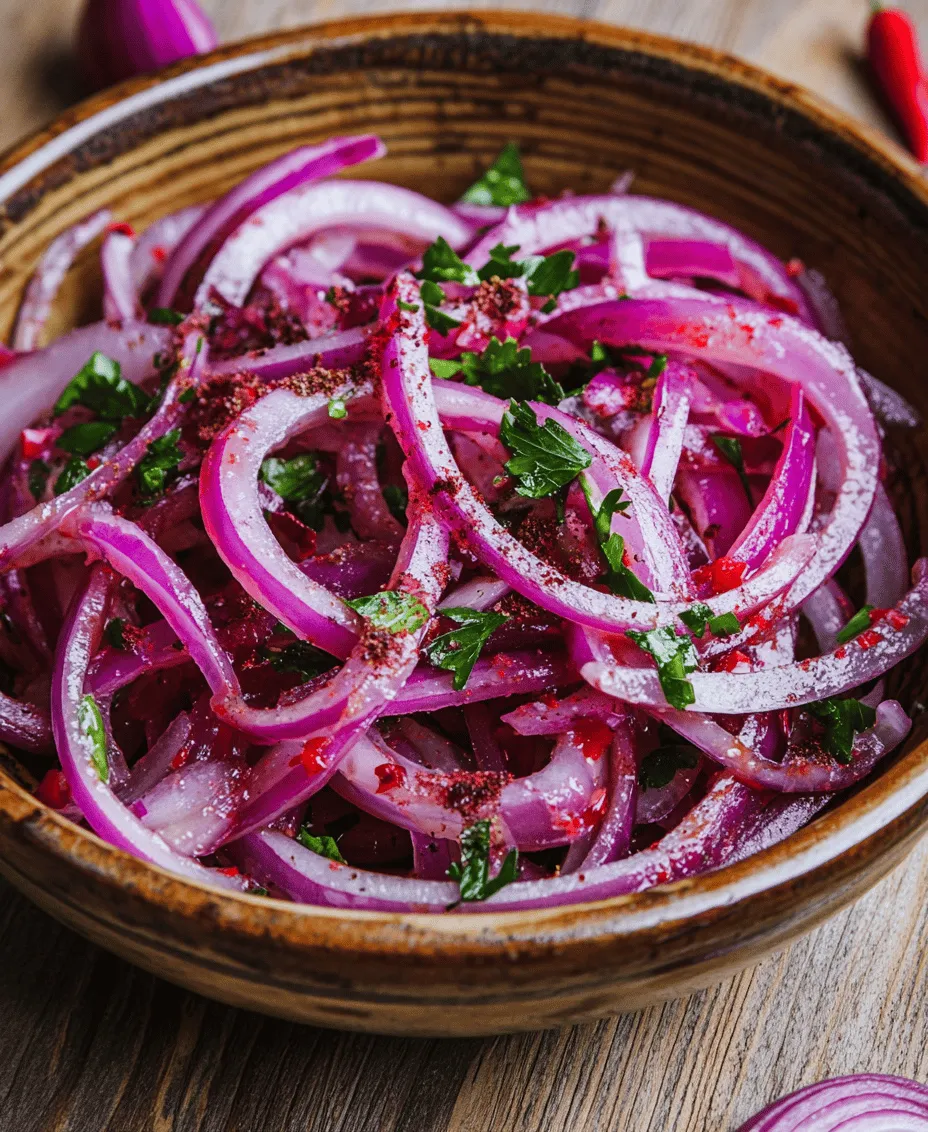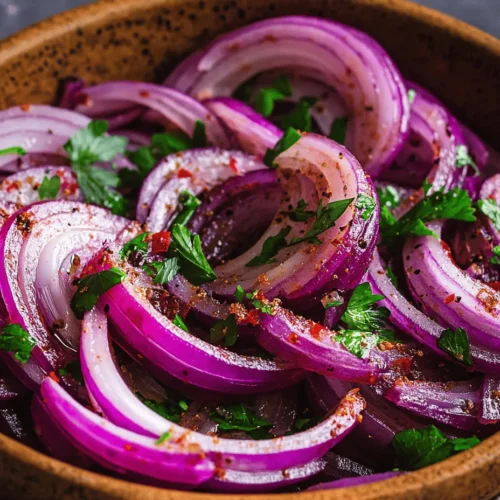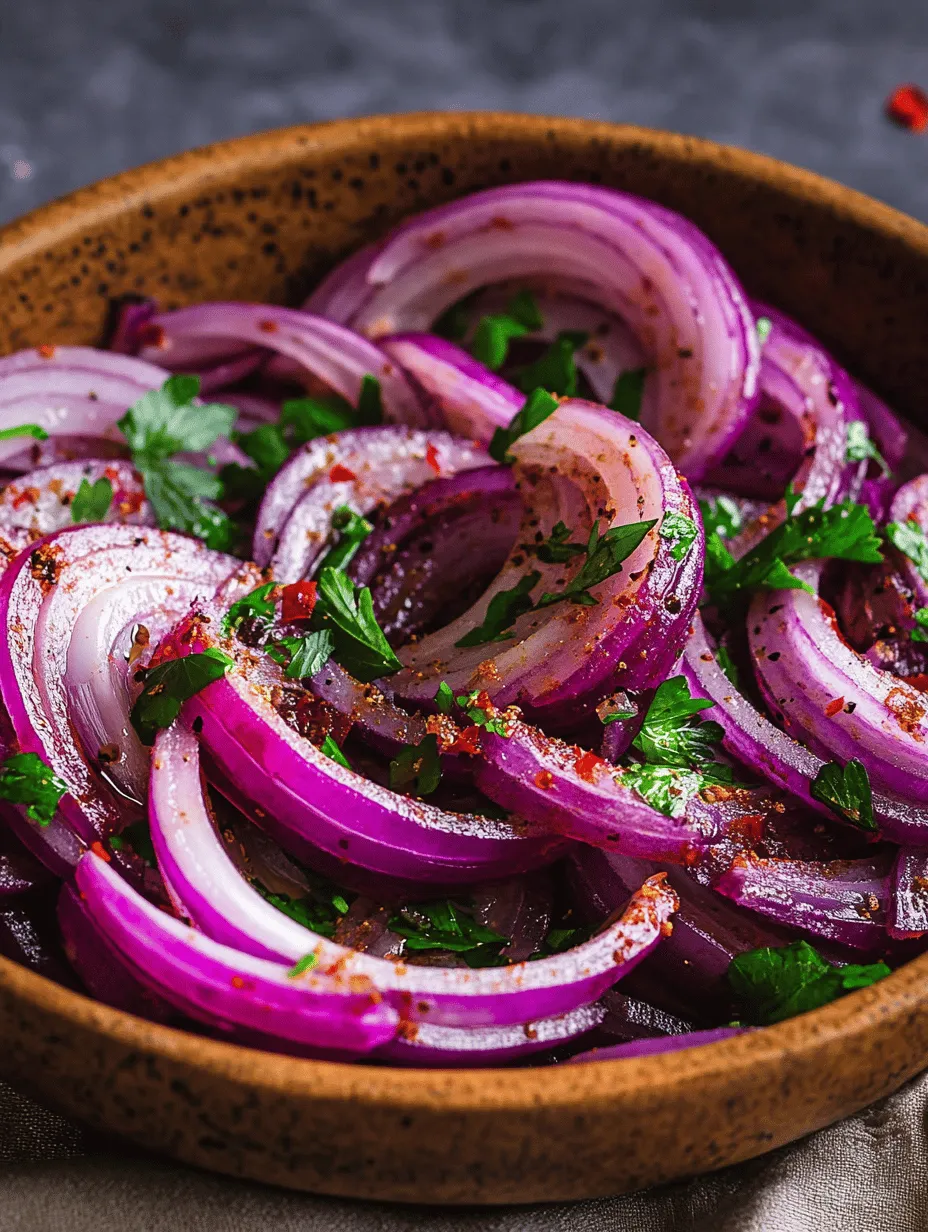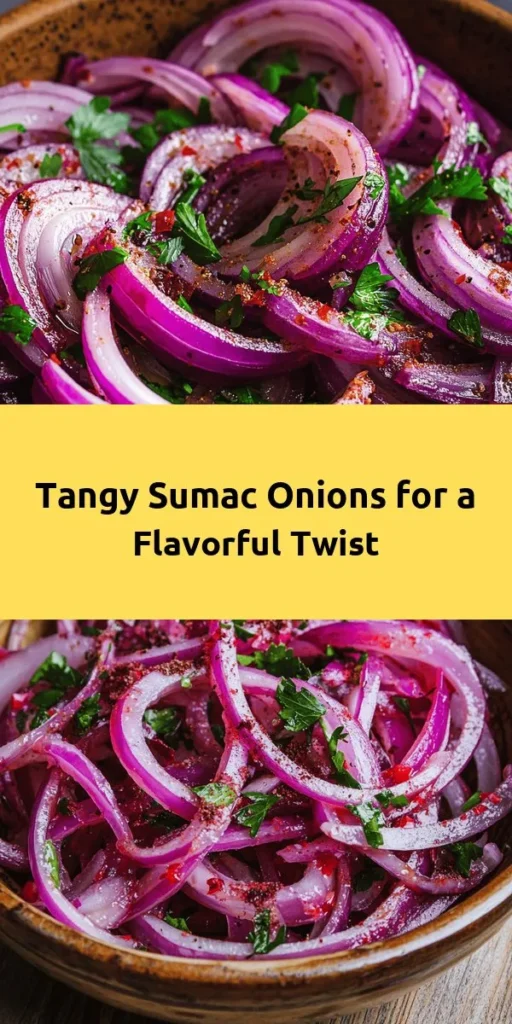Introduction
Sumac onions are a vibrant and flavorful dish that can elevate any meal with their unique tanginess and freshness. Originating from the rich culinary traditions of the Middle East, this dish captures the essence of a region known for its bold flavors and aromatic spices. Sumac, the star ingredient, lends a zesty, lemony flavor that perfectly complements the natural sweetness of red onions. As a side dish or topping, sumac onions not only enhance the taste of your favorite meals but also add a beautiful splash of color to your plate.
Using fresh, high-quality ingredients is paramount in achieving the best results with sumac onions. Fresh onions provide a crunch and sweetness, while sumac brings a distinctive tartness that transforms the dish into a culinary delight. Whether you’re a seasoned home cook or a novice in the kitchen, sumac onions offer an accessible yet exotic experience that allows you to explore unique flavor combinations. As you dive into this recipe, you’ll discover just how simple it is to create a dish that captures the heart of Middle Eastern cuisine.
Understanding Sumac
Sumac, a spice made from the dried and ground berries of the sumac plant, has been a staple in Middle Eastern cooking for centuries. With a deep red to purple hue, it is both visually striking and versatile in its culinary applications. The berries are harvested, dried, and ground into a fine powder, which is then used to impart a tangy, citrus-like flavor profile to various dishes. Its distinct tartness makes it an excellent alternative to lemon juice or vinegar, providing a unique twist to dressings, marinades, and dips.
The flavor profile of sumac is often described as lemony, slightly fruity, and subtly earthy. Its versatility allows it to be used in a wide range of dishes, from grilled meats and vegetables to salads and rice. In addition to its flavor, sumac is packed with nutritional benefits. It is rich in antioxidants and has anti-inflammatory properties, making it a healthy addition to your diet. With a history rooted in ancient culinary practices, sumac not only enhances the taste of food but also serves as a testament to the rich heritage of Middle Eastern cuisine.
The Versatility of Onions
Onions are one of the most commonly used vegetables worldwide and are celebrated for their flavor and health benefits. There are various types of onions, each with its own distinct taste and culinary uses. Red onions, characterized by their vibrant purple skin and sweet flavor, are particularly well-suited for dishes like sumac onions. Their natural sweetness balances the tanginess of sumac and adds a delightful crunch to the dish.
In addition to their flavor, onions are packed with health benefits. They are rich in antioxidants and contain compounds that promote heart health and boost the immune system. The sulfur compounds found in onions are known for their anti-inflammatory properties, making them a great addition to a balanced diet. Onions also play a crucial role in various cuisines around the world, from French onion soup to Indian curries, highlighting their versatility and importance in global culinary traditions.
Sumac Onions Recipe Overview
The sumac onions recipe is a simple yet impactful dish that can be prepared quickly, making it an ideal choice for busy weeknight dinners or as a colorful addition to your entertaining spread. The dish requires minimal cooking time, allowing the fresh ingredients to shine. Typically, sumac onions can be ready in under 30 minutes, making it a fantastic option for those looking to elevate their meals without spending hours in the kitchen.
This dish is incredibly versatile, serving as a delightful topping for grilled meats, a refreshing addition to salads, or even a standalone side dish. Its bright flavors and appealing presentation make it a crowd-pleaser at any gathering. As you explore this recipe, you will find that making sumac onions is not only straightforward but also a rewarding way to introduce new flavors into your culinary repertoire.
Ingredients Breakdown
To create the perfect sumac onions, you will need the following ingredients:
Red Onions
Using red onions is essential for this recipe, as they provide the perfect balance of sweetness and color. Their vibrant hue adds visual appeal to the dish, making it an attractive addition to any meal. When thinly sliced, red onions maintain a satisfying crunch while absorbing the flavors of the other ingredients, resulting in a harmonious blend of tastes.
Olive Oil
A drizzle of high-quality olive oil enhances the overall flavor of the sumac onions while also providing health benefits. Olive oil is rich in monounsaturated fats and antioxidants, making it a heart-healthy choice. It also helps to soften the onions slightly, allowing them to meld beautifully with the tangy sumac.
Sumac
The star ingredient, sumac, is what gives this dish its distinct tanginess. Its unique flavor profile elevates the humble onion, transforming it into a vibrant side dish that can complement a variety of meals. Using freshly ground sumac, if available, will ensure the best flavor and aroma.
Sea Salt
A pinch of sea salt is crucial for enhancing the flavors of the ingredients. Salt not only brings out the natural sweetness of the onions but also balances the acidity of the sumac. Using high-quality sea salt can make a noticeable difference in the overall taste of the dish.
Lemon Juice
Freshly squeezed lemon juice adds brightness and acidity to the sumac onions, further enhancing their flavor profile. The citrus notes from the lemon juice work in harmony with the sumac, creating a lively and refreshing taste that elevates the dish.
Fresh Parsley
Finally, a sprinkle of fresh parsley adds a pop of color and freshness to the dish. Not only does it enhance the visual appeal, but it also complements the flavors of the onions and sumac beautifully. Fresh herbs are an essential component in many cuisines, and parsley is a classic choice that works wonderfully in this recipe.
In the next section, we will delve into the step-by-step instructions to prepare sumac onions, guiding you through the process of creating this delightful dish. Whether you’re looking for a new side dish to accompany your meals or a unique topping for your favorite recipes, sumac onions are sure to impress with their vibrant flavors and simplicity.

Step-by-Step Instructions
To prepare sumac onions, start by gathering your ingredients and tools. You will need fresh red onions, sumac spice, olive oil, salt, and optional chili flakes. A sharp knife, cutting board, mixing bowl, and measuring spoons will make the process smooth.
Preparation of Onions: Importance of Thin Slicing for Marination
Begin by peeling the red onions. The vibrant color and sharp taste of red onions make them ideal for this dish. After peeling, slice the onions thinly. Aim for slices that are about 1/8 inch thick. This thickness is crucial because thinner slices will absorb the marinade more effectively, leading to a better flavor profile. If you prefer a milder onion flavor, consider soaking the sliced onions in cold water for about 10-15 minutes before draining and proceeding with the recipe. This step reduces the sharpness and results in a sweeter taste.
Mixing and Marinating: Explanation of the Marination Process and Its Impact on Flavor
In a mixing bowl, combine the thinly sliced onions with a generous sprinkle of salt. Use your hands to gently massage the salt into the onions. This process not only helps to draw out moisture from the onions but also softens their texture, making them more palatable. Allow the onions to sit for about 10 minutes.
Next, add about two tablespoons of sumac to the bowl, along with three tablespoons of olive oil. If you like a bit of heat, this is the stage to sprinkle in some chili flakes, adjusting the amount to your taste.
Toss the mixture well until all the onions are coated evenly with the sumac, oil, and salt. The sumac will add a tangy, lemony flavor that complements the onions beautifully. Allow the onions to marinate for at least 30 minutes at room temperature. For a more intense flavor, consider refrigerating them for a few hours or even overnight. The longer the marination, the deeper the flavors will develop.
Final Touches: Adding Lemon Juice and Optional Chili Flakes
Before serving, give the marinated onions a final touch by adding the juice of half a lemon. This addition brightens the overall flavor and balances the richness of the olive oil. If you enjoy the spice, feel free to add more chili flakes at this stage. Stir well to combine, ensuring every slice gets a taste of the delicious marinade.
Presentation Tips for Serving
Presentation is key when serving sumac onions. Transfer the marinated onions to a serving dish, allowing them to retain some of the marinade. Consider garnishing with a sprinkle of fresh herbs, such as parsley or mint, for a pop of color and freshness. Serve the sumac onions alongside your main dishes for an appealing and vibrant addition.
For visual aids, consider photographing the process of slicing the onions, the mixing of ingredients, and the final plated dish. These images will enhance understanding and engage your readers as they prepare the recipe themselves.
Serving Suggestions
Sumac onions are incredibly versatile and can complement a variety of dishes. Here are some ideas for incorporating them into your meals:
1. As a Topping for Grilled Meats: The tangy flavor of sumac onions pairs beautifully with grilled chicken, lamb, or beef. The acidity of the onions cuts through the richness of the meat, enhancing the overall flavor profile.
2. Inclusion in Sandwiches: Add a layer of sumac onions to your favorite sandwiches or wraps. They provide a crunchy texture and a burst of flavor that elevates even the simplest of sandwiches.
3. Use in Salads: Incorporate sumac onions into Mediterranean-style salads. They can brighten up a simple greens salad, or you can mix them with chickpeas, cucumbers, and tomatoes for a refreshing side dish.
4. Suggestions for Incorporating Sumac Onions into Meal Prep: Prepare a larger batch of sumac onions and store them in an airtight container in the refrigerator. They can last for up to a week, making them a convenient addition to your meal prep. Use them to add flavor to grain bowls, tacos, or even as a topping for baked potatoes.
Cultural Significance of Sumac Onions
Sumac is a staple spice in Middle Eastern cuisine, known for its vibrant color and tangy flavor. In many cultures, sumac is used to enhance dishes and provide a burst of acidity without the need for fresh lemon. Sumac onions reflect this culinary tradition, showcasing the importance of balancing flavors in Middle Eastern cooking.
Traditional dishes that feature sumac onions include kebabs and shawarma, where the onions serve as a refreshing counterpoint to rich meats. In addition, many Middle Eastern salads, such as fattoush, incorporate sumac for its distinctive taste. This recipe not only highlights the versatility of sumac but also pays homage to the rich cultural heritage from which it originates.
Nutritional Analysis
A serving of sumac onions is low in calories while providing a wealth of flavor and nutrition. Here’s a breakdown of the nutritional value per serving:
– Calories: Approximately 70
– Fat: 7g (mainly from olive oil)
– Carbohydrates: 3g
– Fiber: 1g
– Protein: 1g
This dish is an excellent source of antioxidants and vitamins, thanks to the fresh onions and sumac. The inclusion of olive oil adds healthy fats that are beneficial for heart health. Incorporating sumac onions into your meals can contribute to a balanced diet, providing flavor without excessive calories or unhealthy additives.
Conclusion
Sumac onions offer a simple yet flavorful addition to any meal, bringing a touch of Middle Eastern inspiration to your table. With their tangy taste and vibrant appearance, they can elevate everyday dishes and impress your guests. As you experiment with this recipe, consider trying out different flavor combinations and using them in various contexts.
Encourage yourself to make sumac onions a staple in your cooking repertoire. The joy of working with fresh ingredients and exploring diverse cuisines is unmatched. This dish not only enhances your meals but also connects you with culinary traditions that have stood the test of time. Enjoy the process of cooking and the delicious results that come from it!



